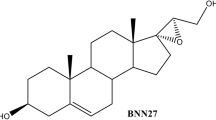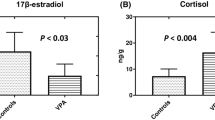Abstract
Rationale
Androsterone [(3α,5α)-3-hydroxyandrostan-17-one; 5α,3α-A] and its 5β-epimer etiocholanolone [(3α,5β)-3-hydroxyandrostan-17-one; 5β,3α-A)], the major excreted metabolites of testosterone, are neurosteroid positive modulators of GABAA receptors. Such neurosteroids typically show enantioselectivity in which the natural form is more potent than the corresponding unnatural enantiomer. For 5α,3α-A and 5β,3α-A, the unnatural enantiomers are more potent at GABAA receptors than the natural forms.
Objectives
The aim of this study was to compare the anticonvulsant potencies and time courses of 5α,3α-A and 5β,3α-A with their enantiomers in mouse seizure models.
Methods
Steroids were administered intraperitoneally to male NIH Swiss mice 15 min (or up to 6 h in time course experiments) prior to administration of an electrical stimulus in the 6-Hz or maximal electroshock (MES) seizure tests or the convulsant pentylenetetrazol (PTZ).
Results
In the 6-Hz test, the ED50 values of ent-5α,3α-A was 5.0 mg/kg whereas the value for 5α,3α-A was 12.1 mg/kg; the corresponding values in the PTZ seizure test were 22.8 and 51.8 mg/kg. Neurosteroid GABAA receptor-positive allosteric modulators are generally weak in the MES seizure test and this was confirmed in the present study. However, the atypical relative potency relationship was maintained with ED50 values of 140 and 223 mg/kg for ent-5α,3α-A and 5α,3α-A, respectively. Similar relationships were obtained for the 5β-isomers, except that the enantioselectivity was accentuated. In the 6-Hz and PTZ tests, the ED50 values of ent-5β,3α-A were 11.8 and 20.4 mg/kg whereas the values for 5β,3α-A were 57.6 and 109.1 mg/kg. Protective activity in the 6-Hz test of ent-5α,3α-A persisted for somewhat longer (~5 h) than for 5α,3α-A (~4 h); protection by ent-5β,3α-A also persisted longer (~3 h) than for 5β,3α-A (~2 h).
Conclusions
The unnatural enantiomers of 17-keto androgen class neurosteroids have greater in vivo potency and a longer duration of action than their natural counterparts. The more prolonged duration of action of the unnatural enantiomers could reflect reduced susceptibility to metabolism. Unnatural enantiomers of androgen class neurosteroids could have therapeutic utility and may provide advantages over the corresponding natural isomers due to enhanced potency and improved pharmacokinetic characteristics.





Similar content being viewed by others
Abbreviations
- 5α,3α-A:
-
Androsterone
- 5β,3α-A:
-
Etiocholanolone
- ent-5α,3α-A:
-
ent-Androsterone
- ent-5β,3α-A:
-
ent-Etiocholanolone
- PTZ:
-
Pentylenetetrazol
- MES:
-
Maximal electroshock
- PI:
-
Protective index
- SAR:
-
Structure–activity relationship
References
Anderson A, Boyd AC, Clark JK, Fielding L, Gemmell DK, Hamilton NM, Maidment MS, May V, McGuire R, McPhail P, Sansbury FH, Sundaram H, Taylor R (2000) Conformationally constrained anesthetic steroids that modulate GABAA receptors. J Med Chem 43:4118–4125
Bialer M, Johannessen SI, Levy RH, Perucca E, Tomson T, White HS (2013) Progress report on new antiepileptic drugs: a summary of the Eleventh Eilat Conference (EILAT XI). Epilepsy Res 103:2–30
Covey DF (2009) ent-Steroids: novel tools for studies of signaling pathways. Steroids 74:577–585
Covey DF, Nathan D, Kalkbrenner M, Nilsson KR, Hu Y, Zorumski CF, Evers AS (2000) Enantioselectivity of pregnanolone-induced γ-aminobutyric acidA receptor modulation and anesthesia. J Pharmacol Exp Ther 293:1009–1016
Hawkinson JE, Kimbrough CL, Belelli D, Lambert JJ, Purdy RH, Lan NC (1994) Correlation of neuroactive steroid modulation of [35S]t-butylbicyclophosphorothionate and [3H]flunitrazepam binding and γ-aminobutyric acidA receptor function. Mol Pharmacol 46:977–985
Hosie AM, Clarke L, da Silva H, Smart TG (2009) Conserved site for neurosteroid modulation of GABAA receptors. Neuropharmacology 6:149–154
Kaminski RM, Livingood MR, Rogawski MA (2004) Allopregnanolone analogs that positively modulate GABAA receptors protect against partial seizures induced by 6 Hz electrical stimulation in mice. Epilepsia 45:1–4
Kaminski RM, Marini H, Kim WJ, Rogawski MA (2005) Anticonvulsant activity of androsterone and etiocholanolone. Epilepsia 46:819–827
Katona BW, Krishnan K, Cai ZY, Manion BD, Benz A, Taylor A, Evers AS, Zorumski CF, Mennerick S, Covey DF (2008) Neurosteroid analogues. 12. Potent enhancement of GABA-mediated chloride currents at GABAA receptors by ent-androgens. Eur J Med Chem 43:107–113
Kokate TG, Svensson BE, Rogawski MA (1994) Anticonvulsant activity of neurosteroids: correlation with γ-aminobutyric acid evoked chloride current potentiation. J Pharmacol Exp Ther 270:1223–1229
Kokate TG, Banks MK, Magee T, Yamaguchi S, Rogawski MA (1999) Finasteride, a 5α-reductase inhibitor, blocks the anticonvulsant activity of progesterone in mice. J Pharmacol Exp Ther 288:679–684
Krall RL, Penry JK, White BG, Kupferberg HJ, Swinyard EA (1978) Antiepileptic drug development: II. Anticonvulsant drug screening. Epilepsia 19:409–428
Krishnan K, Manion BD, Taylor A, Bracamontes J, Steinbach JH, Reichert DE, Evers AS, Zorumski CF, Mennerick S, Covey DF (2012) Neurosteroid analogues. 17. Inverted binding orientations of androsterone enantiomers at the steroid potentiation site on γ-aminobutyric acid type A receptors. J Med Chem 55:1334–1345
Lambert JJ, Cooper MA, Simmons RD, Weir CJ, Belelli D (2009) Neurosteroids: endogenous allosteric modulators of GABAA receptors. Psychoneuroendocrinology 34(Suppl 1):S48–S58
Lehmann FPA, Rodrigues de Miranda JF, Ariëns EJ (1976) Stereoselectivity and affinity in molecular pharmacology. Prog Drug Res 20:101–142
Morrow AL, Pace JR, Purdy RH, Paul SM (1990) Characterization of steroid interactions with γ-aminobutyric acid receptor-gated chloride ion channels: evidence for multiple steroid recognition sites. Mol Pharmacol 37:263–270
Paul SM, Purdy RH (1992) Neuroactive steroids. FASEB J 6:2311–2322
Reddy DS, Rogawski MA (2000) Enhanced anticonvulsant activity of ganaxolone after neurosteroid withdrawal in a rat model of catamenial epilepsy. J Pharmacol Exp Ther 294:909–915
Reddy DS, Rogawski MA (2002) Stress-induced deoxycorticosterone-derived neurosteroids modulate GABAA receptor function and seizure susceptibility. J Neurosci 22:3795–3805
Reddy DS, Rogawski MA (2012) Neurosteroids—endogenous regulators of seizure susceptibility and role in the treatment of epilepsy (Chapter 77). In: Noebels JL, Avoli M, Rogawski MA, Olsen RW, Delgado-Escueta AV (eds) Jasper’s basic mechanisms of the epilepsies, 4th edn. Oxford University Press, Oxford, pp 984–1002
Turner DM, Ransom RW, Yang JS, Olsen RW (1989) Steroid anesthetics and naturally occurring analogs modulate the γ-aminobutyric acid receptor complex at a site distinct from barbiturates. J Pharmacol Exp Ther 248:960–966
Wittmer LL, Hu Y, Kalkbrenner M, Evers AS, Zorumski CF, Covey DF (1996) Enantioselectivity of steroid-induced γ-aminobutyric acidA receptor modulation and anesthesia. Mol Pharmacol 50:1581–1586
Acknowledgments
This study was supported in part by the National Institute of Neurological Disorders and Stroke of the National Institutes of Health under award number NS079202 (M.A.R.) and the National Institute of General Medical Sciences of the National Institutes of Health under award number GM47969 (D.F.C.). The experiments were conducted in compliance with all applicable laws and regulations.
Conflict of interest
The authors declare no conflicts of interest.
Author information
Authors and Affiliations
Corresponding author
Rights and permissions
About this article
Cite this article
Zolkowska, D., Dhir, A., Krishnan, K. et al. Anticonvulsant potencies of the enantiomers of the neurosteroids androsterone and etiocholanolone exceed those of the natural forms. Psychopharmacology 231, 3325–3332 (2014). https://doi.org/10.1007/s00213-014-3546-x
Received:
Accepted:
Published:
Issue Date:
DOI: https://doi.org/10.1007/s00213-014-3546-x




